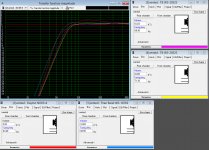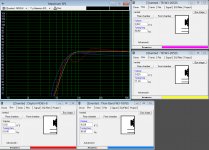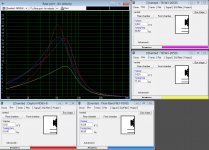Hi there, it's nice to came back in DIY audio hobby 
There is a funny challange here. The idea is to eat some Pringles with my sons and say "Hmm.. Can we make speaker with theses cans ?"
Yeah, easy ! Just put a little 4$ 3" drive on the end... Ok but i think it will be funny only if it sound good. Like "D'uh, dad, it's sound like a true speaker!"
Ok.. My first idea was to build two way speakers with 3" TB 'subwoofer' like W3-1876S, W3-2052S and one or two Tymphany 30N18AL03. 'Subwoofer' face to the desk (with spacer to let it breath) with flexible plastic tubbing port. Two way with 2k crossover.
The second idea was to do fullrange with Dayton Audio ND65-8, ported.
The third idea was to make a stereo tube speaker like this one.
The fourth idea was to make a mini sss inspired by Elias SSS .
I like the idea of a small one piece stereo sound system for bedroom. I have two size of cans. Inside dimensions : large : 72mm diameter with 243mm heigh. small : same diameter but 118mm heigh. I got steel can of 83mm diameter and 185mm heigh.
Volume :
Big Pringles : 0.035 cu ft (1L)
Small Pringles : 0.017 cu ft (0.48L)
Milk cans : 0.035 cu ft (1L)
I can make a H shape with three can ... I look at many solutions and i begin to be lost... So i need your opinion, advice and help, please.
I'll post the Win ISD plot early about TB 'subwoofer'
Thank you all
There is a funny challange here. The idea is to eat some Pringles with my sons and say "Hmm.. Can we make speaker with theses cans ?"
Yeah, easy ! Just put a little 4$ 3" drive on the end... Ok but i think it will be funny only if it sound good. Like "D'uh, dad, it's sound like a true speaker!"
Ok.. My first idea was to build two way speakers with 3" TB 'subwoofer' like W3-1876S, W3-2052S and one or two Tymphany 30N18AL03. 'Subwoofer' face to the desk (with spacer to let it breath) with flexible plastic tubbing port. Two way with 2k crossover.
The second idea was to do fullrange with Dayton Audio ND65-8, ported.
The third idea was to make a stereo tube speaker like this one.
The fourth idea was to make a mini sss inspired by Elias SSS .
I like the idea of a small one piece stereo sound system for bedroom. I have two size of cans. Inside dimensions : large : 72mm diameter with 243mm heigh. small : same diameter but 118mm heigh. I got steel can of 83mm diameter and 185mm heigh.
Volume :
Big Pringles : 0.035 cu ft (1L)
Small Pringles : 0.017 cu ft (0.48L)
Milk cans : 0.035 cu ft (1L)
I can make a H shape with three can ... I look at many solutions and i begin to be lost... So i need your opinion, advice and help, please.
I'll post the Win ISD plot early about TB 'subwoofer'
Thank you all
What about the losses ?
Most of the energy would be directly transferred and dissipated by the pringles can itself,
being it quite sound-transparent and easy to deform.
I was to suggest to try bitumen foil+felt waste. You can find it at an automotive shop.
But the whole structure needs more stiffening. The cylindrical form doesn't make it too bad, after all ...
Oh Btw
I made a pair of boxes with cylinders some months ago. They need to have a certain weight, in the end...
so any addition to limit vibrations and to absorb internal reflections is good thing.
Most of the energy would be directly transferred and dissipated by the pringles can itself,
being it quite sound-transparent and easy to deform.
I was to suggest to try bitumen foil+felt waste. You can find it at an automotive shop.
But the whole structure needs more stiffening. The cylindrical form doesn't make it too bad, after all ...
Oh Btw
I made a pair of boxes with cylinders some months ago. They need to have a certain weight, in the end...
so any addition to limit vibrations and to absorb internal reflections is good thing.
Last edited:
PVC Pipe Instead
It will require much less effort & deliver superior results.
WHG
Hi there, it's nice to came back in DIY audio hobby
There is a funny challange here. The idea is to eat some Pringles with my sons and say "Hmm.. Can we make speaker with theses cans ?"
Yeah, easy ! Just put a little 4$ 3" drive on the end... Ok but i think it will be funny only if it sound good. Like "D'uh, dad, it's sound like a true speaker!"
Ok.. My first idea was to build two way speakers with 3" TB 'subwoofer' like W3-1876S, W3-2052S and one or two Tymphany 30N18AL03. 'Subwoofer' face to the desk (with spacer to let it breath) with flexible plastic tubbing port. Two way with 2k crossover.
The second idea was to do fullrange with Dayton Audio ND65-8, ported.
The third idea was to make a stereo tube speaker like this one.
The fourth idea was to make a mini sss inspired by Elias SSS .
I like the idea of a small one piece stereo sound system for bedroom. I have two size of cans. Inside dimensions : large : 72mm diameter with 243mm heigh. small : same diameter but 118mm heigh. I got steel can of 83mm diameter and 185mm heigh.
Volume :
Big Pringles : 0.035 cu ft (1L)
Small Pringles : 0.017 cu ft (0.48L)
Milk cans : 0.035 cu ft (1L)
I can make a H shape with three can ... I look at many solutions and i begin to be lost... So i need your opinion, advice and help, please.
I'll post the Win ISD plot early about TB 'subwoofer'
Thank you all
It will require much less effort & deliver superior results.
WHG
It will require much less effort & deliver superior results.
WHG
Are you talking about the H shape stereo system ?
I see system with common volume for two stereo driver... I don't think it's a good idea. Why have they do that ?
Thanks
Not Particularly.
PVC pipe is just acoustically and mechanically superior enclosure material to Pringles cans. It is inexpensive and easy to join using the fittings that are available. Expansion joints make enclosure tuning an interesting project for students.
N.B. For an H enclosure, the driver interaction occurs at low frequencies only, where the signal is common to both channels. The H arrangement is only practical for near field listening venues, where right and left enclosure separation is of nominal concern.
Regards,
WHG
Are you talking about the H shape stereo system ?
I see system with common volume for two stereo driver... I don't think it's a good idea. Why have they do that ?
Thanks
PVC pipe is just acoustically and mechanically superior enclosure material to Pringles cans. It is inexpensive and easy to join using the fittings that are available. Expansion joints make enclosure tuning an interesting project for students.
N.B. For an H enclosure, the driver interaction occurs at low frequencies only, where the signal is common to both channels. The H arrangement is only practical for near field listening venues, where right and left enclosure separation is of nominal concern.
Regards,
WHG
I found a defective Logitech S125i. I will make a small H arrangement. I will use Pringles can for the kids (age 4, 6 ans 12). I already have the cans.
I will probably make an other system with good drivers, PVC and small class D amplifier later.
I will probably make an other system with good drivers, PVC and small class D amplifier later.
N.B. For an H enclosure, the driver interaction occurs at low frequencies only, where the signal is common to both channels. The H arrangement is only practical for near field listening venues, where right and left enclosure separation is of nominal concern.
WHG
Is that exist a defined safe frequency range for common comprtment arrangement ?
Thank you
More
In general, the studio mix determines at what frequency, below which, the right and left LF signals have been blended. However, when signal wave length becomes comparable to speaker separation (in this case, closely spaced), the drivers are going to interact at and below those frequencies irrespective of whether they are housed in separate or joined enclosures.
At this point you will not be able to tell from which driver the signals are comming from due to this close spacing.
At frequencies above this range, assuming sufficient lining of interior enclosure walls, there will be negligible audible effect. It is the isolation of tweeters by separate back boxes that is important, not if the woofers are “joined at the hip”.
Regards,
WHG
Is that exist a defined safe frequency range for common comprtment arrangement ?
Thank you
In general, the studio mix determines at what frequency, below which, the right and left LF signals have been blended. However, when signal wave length becomes comparable to speaker separation (in this case, closely spaced), the drivers are going to interact at and below those frequencies irrespective of whether they are housed in separate or joined enclosures.
At this point you will not be able to tell from which driver the signals are comming from due to this close spacing.
At frequencies above this range, assuming sufficient lining of interior enclosure walls, there will be negligible audible effect. It is the isolation of tweeters by separate back boxes that is important, not if the woofers are “joined at the hip”.
Regards,
WHG
- Status
- This old topic is closed. If you want to reopen this topic, contact a moderator using the "Report Post" button.
- Home
- Loudspeakers
- Multi-Way
- Playing with Pringles Can : Kid's projects must sond good too !


